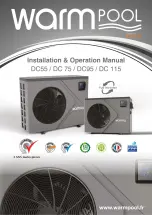
6 Configuration
Installation and operation manual
20
4BY1
Air-cooled refrigeration condensing unit
4P495373-1 – 2017.07
Connecting to the
frame
When cables are routed from the unit, a
protection sleeve for the conduits (PG
insertions) can be inserted at the knockout
hole.
When you do not use a wire conduit,
protect the wires with vinyl tubes to
prevent the edge of the knockout hole from
cutting the wires.
a b c
d
e
A B
A
Inside of the outdoor unit
B
Outside of the outdoor unit
a
Wire
b
Bush
c
Nut
d
Frame
e
Hose
9
Reattach the service cover.
10
Connect an earth leakage circuit breaker and fuse to the power
supply line.
6
Configuration
INFORMATION
It is important that all information in this chapter is read
sequentially by the installer and that the system is
configured as applicable.
DANGER: RISK OF ELECTROCUTION
6.1
Making field settings
6.1.1
About making field settings
INFORMATION
The LEDs and buttons are located in the outdoor module
(not in the hydro module).
To configure the condensing unit, you must give input to the outdoor
unit's main PCB (A1P). This involves the following field setting
components:
▪ Push buttons to give input to the PCB
▪ A display to read feedback from the PCB
Field settings are defined by their mode, setting and value. Example:
[2‑1]=2.
PC configurator
It is alternatively possible to make several commissioning field
settings through a personal computer interface (for this, option
EKPCCAB is required). The installer can prepare the configuration
(off-site) on PC and afterwards upload the configuration to the
system.
See also:
"6.1.9 To connect the PC configurator to the outdoor
unit" on page 23
.
Mode 1 and 2
Mode
Description
Mode 1
(monitoring
settings)
Mode 1 can be used to monitor the current
situation of the outdoor unit. Some field setting
contents can be monitored as well.
Mode 2
(field settings)
Mode 2 is used to change the field settings of
the system. Consulting the current field setting
value and changing the current field setting
value is possible.
In general, normal operation can be resumed
without special intervention after changing field
settings.
Some field settings are used for special
operation. In such a case, it is required to abort
the special operation before normal operation
can restart. It will be indicated in below
explanations.
6.1.2
To access the field setting components
See
"5.1.1 To open the outdoor unit" on page 9
.
6.1.3
Field setting components
NOTICE
The DIP switch (DS1 on A1P) is not used. Do NOT change
the factory setting.
The components to make field settings are as follows:
BS2
SET
BS1
MODE
BS3
RETURN
BS4
TEST
BS5
RESET
H1P
H2P
H3P
H4P
H5P
H6P
H7P
H8P
A1P
A2P
X1M
X3M
X2M
MULTI
DEMAND
L.N.O.P.
SLAVE
MASTER
IND
TEST/
HWL
MODE
BS1~BS5
Push buttons
H1P~H7P
7‑LEDs display
H8P
LED for indication during initialisation
ON (
) OFF ( ) Flashing (
)
Push buttons
Use the push buttons to make the field settings. Operate the push
buttons with an insulated stick (such as a closed ball-point pen) to
avoid touching of live parts.
BS1
MODE: For changing the set mode
BS2
SET: For field setting
BS3
RETURN: For field setting
BS4
Not used
BS5
Not used
7‑LEDs display
The display gives feedback about the field settings, which are
defined as [Mode-Setting]=Value.
H1P
Shows the mode
H2P~H7P
Shows the settings and values, represented in binary code
H8P
NOT used for field settings, but used during initialisation
Example:
H1P H2P H3P H4P H5P H6P H7P
-
+
+
+
+
+
[
H1P
32 16
8
4
2
1]
Description
(H1P OFF)
Default situation
(H1P flashing)
Mode 1
Summary of Contents for LRMEQ3BY1
Page 31: ......
Page 32: ...4P495373 1 2017 07 Copyright 2016 Daikin 4P495373 1 0000000T...













































